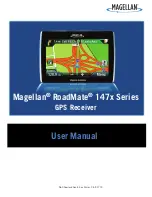
C-Nav2050 User Guide
CAN Bus/Event (C-Nav2050M only)
The C-Nav2050M provides a balanced (differential)
2-wire CAN Bus technology interface, ISO11898 -24V
compliant. The CAN interface uses an asynchronous
transmission scheme employing serial binary
interchange widely used in the automotive industry. The
data rate is defined as 250Kbps maximum with
termination resistors at each end of the cable. This
port/connector is shared with the Event Input.
CAN Bus specifications are diverse.
Drivers for the existing hardware must be
tailored to the specific manufacturer’s
equipment being interfaced. For further
information, contact C-Nav Support.
Event
The C-Nav2050M accepts an event input pulse to
synchronize external incidents requiring precise GPS
time tagging, such as aerial photography. For example,
the action of a camera’s aperture could send a pulse to
the
Event
port of the C-Nav2050M. This would give the
user output position information relative to the time the
photograph was taken.
Specifications:
50 Ohm input impedance
3VDC > Input Voltage, High < 6VDC
0VDC < Input Voltage, Low < 1.2VDC
Minimum pulse width, 100 nsec
Rising or Falling edge Synchronization
Connecting the shared EVT MKR/CAN BUS port
requires a five core, 5mm diameter, cable fitted with a
2-8
Summary of Contents for 2050M
Page 30: ...C Nav2050 User Guide xxviii ...
Page 42: ...C Nav2050 User Guide 1 12 ...
Page 56: ...C Nav2050 User Guide 2 14 ...
Page 86: ...C Nav2050 User Guide 4 12 ...
Page 96: ...C Nav2050 User Guide A 8 ...
Page 104: ...C Nav2050 User Guide B 8 ...
Page 115: ...C Nav2050 User Guide NCT Format Field 14 Navigation Mode D 5 ...
Page 125: ...C Nav2050 User Guide Appendix E Certificates Certificate of Registration E 1 ...
Page 126: ...C Nav2050 User Guide E 2 ...
Page 127: ...C Nav2050 User Guide Certificate of Type Approval E 3 ...
Page 128: ...C Nav2050 User Guide E 4 ...
Page 129: ...C Nav2050 User Guide E 5 ...
Page 132: ...C Nav2050 User Guide F 2 ...
Page 165: ...NOTES ...
Page 166: ......
















































